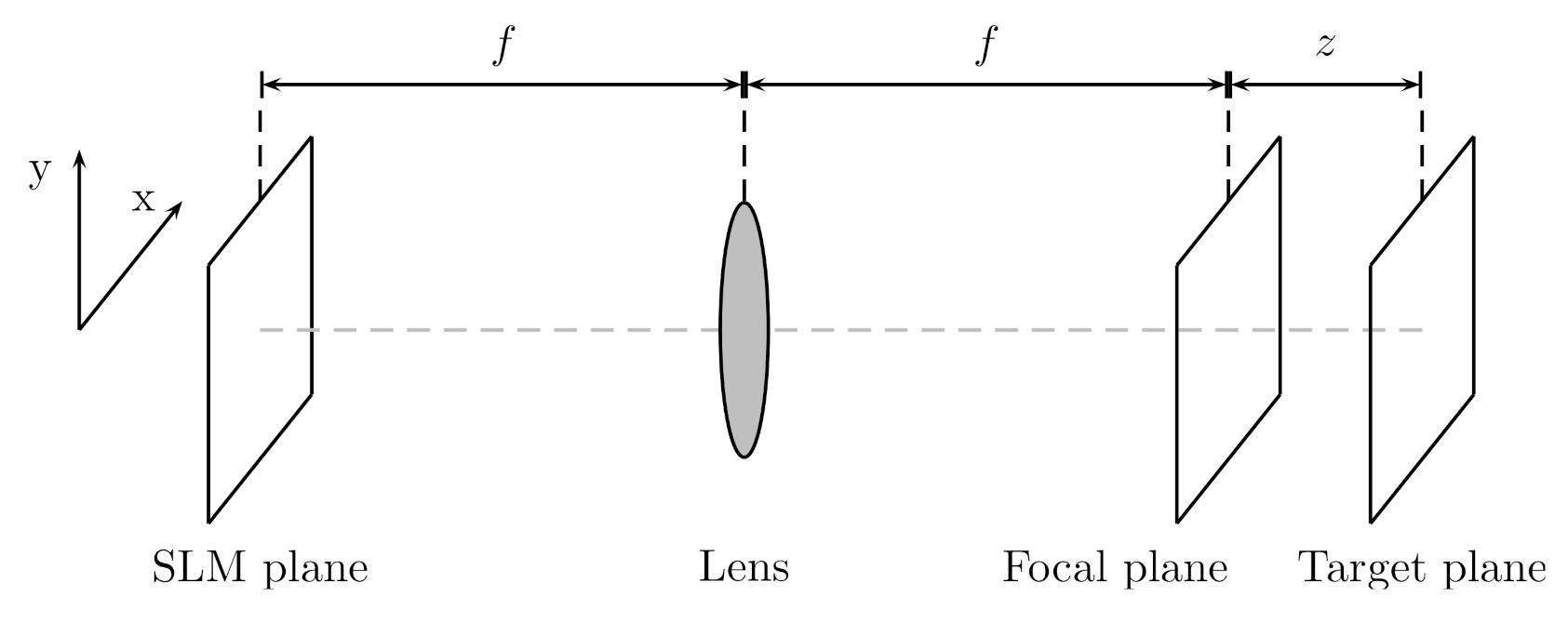Proximal Algorithms for Discrete-Level Phase-Shifting Mask Design with Application to Optogenetics
Abstract
:1. Introduction
2. Materials and Methods
2.1. Problem Formulation
2.2. The Proposed Approach
2.3. Derivation of the Proximal Gradient Algorithm
3. Results
4. Discussion
Author Contributions
Funding
Institutional Review Board Statement
Informed Consent Statement
Conflicts of Interest
References
- Deisseroth, K. Optogenetics. Nat. Methods 2011, 8, 26–29. [Google Scholar] [CrossRef]
- Papagiakoumou, E. Optical developments for optogenetics. Biol. Cell 2013, 105, 443–464. [Google Scholar] [CrossRef] [PubMed]
- Schmieder, F.; Klapper, S.D.; Koukourakis, N.; Busskamp, V.; Czarske, J.W. Optogenetic stimulation of human neural networks using fast ferroelectric spatial light modulator—Based holographic illumination. Appl. Sci. 2018, 8, 1180. [Google Scholar] [CrossRef] [Green Version]
- Ampeliotis, D.; Politi, C.; Anastasiou, A.; Alexandropoulos, D. A Regularized Optimization Approach for Optogenetic Stimulation using Ferroelectric SLMs. In SPIE Optical System Design (Computational Optics 2021); SPIE: Bellingham, WA, USA, 2021. [Google Scholar]
- Hamam, H.; de la Tocnaye, J.d.B. Fractional Talbot four-level phase-only holograms using ferroelectric liquid-crystal spatial light modulators. Opt. Lett. 1994, 19, 1654–1656. [Google Scholar] [CrossRef] [PubMed]
- Liu, Y.; Zakhor, A. Binary and phase shifting mask design for optical lithography. IEEE Trans. Semicond. Manuf. 1992, 5, 138–152. [Google Scholar] [CrossRef]
- Sherif, S.; Saleh, B.; De Leone, R. Binary image synthesis using mixed linear integer programming. IEEE Trans. Image Process. 1995, 4, 1252–1257. [Google Scholar] [CrossRef] [PubMed]
- Pati, Y.; Kailath, T. Phase-shifting masks for microlithography: Automated design and mask requirements. JOSA A 1994, 11, 2438–2452. [Google Scholar] [CrossRef]
- Erdmann, A.; Fuehner, T.; Schnattinger, T.; Tollkuehn, B. Toward automatic mask and source optimization for optical lithography. In Proceedings of the Optical Microlithography XVII, Santa Clara, CA, USA, 24–27 February 2004; International Society for Optics and Photonics: Bellingham, WA, USA, 2004; Volume 5377, pp. 646–657. [Google Scholar]
- Poonawala, A.; Milanfar, P. OPC and PSM design using inverse lithography: A nonlinear optimization approach. In Optical Microlithography XIX; International Society for Optics and Photonics: Bellingham, WA, USA, 2006; Volume 6154, p. 61543H. [Google Scholar]
- Ma, X.; Arce, G.R. Generalized inverse lithography methods for phase-shifting mask design. Opt. Express 2007, 15, 15066–15079. [Google Scholar] [CrossRef] [PubMed]
- Monga, V.; Li, Y.; Eldar, Y.C. Algorithm unrolling: Interpretable, efficient deep learning for signal and image processing. IEEE Signal Process. Mag. 2021, 38, 18–44. [Google Scholar] [CrossRef]
- Ma, X.; Zhao, Q.; Zhang, H.; Wang, Z.; Arce, G.R. Model-driven convolution neural network for inverse lithography. Opt. Express 2018, 26, 32565–32584. [Google Scholar] [CrossRef] [PubMed]
- Ma, X.; Zheng, X.; Arce, G.R. Fast inverse lithography based on dual-channel model-driven deep learning. Opt. Express 2020, 28, 20404–20421. [Google Scholar] [CrossRef] [PubMed]
- Yu, J.C.; Yu, P. Impacts of cost functions on inverse lithography patterning. Opt. Express 2010, 18, 23331–23342. [Google Scholar] [CrossRef] [PubMed]
- Boyd, S.; Xiao, L.; Mutapcic, A. Subgradient Methods; Lecture Notes of EE392o; Stanford University: Stanford, CA, USA, 2003; Volume 2004, pp. 2004–2005. [Google Scholar]
- Parikh, N.; Boyd, S. Proximal algorithms. Found. Trends Optim. 2014, 1, 127–239. [Google Scholar] [CrossRef]
- Zhang, J.; Pégard, N.; Zhong, J.; Adesnik, H.; Waller, L. 3D computer-generated holography by non-convex optimization. Optica 2017, 4, 1306–1313. [Google Scholar] [CrossRef]
- Kaplan, A.; Tichatschke, R. Proximal point methods and nonconvex optimization. J. Glob. Optim. 1998, 13, 389–406. [Google Scholar] [CrossRef]
- Tibshirani, R. Regression shrinkage and selection via the lasso. J. R. Stat. Soc. Ser. B 1996, 58, 267–288. [Google Scholar] [CrossRef]
- Schmidt, J.D. Numerical Simulation of Optical Wave Propagation: With Examples in MATLAB; SPIE: Bellingham, WA, USA, 2010; pp. 1–197. [Google Scholar] [CrossRef]




| Quantization | Approach in [11] | Approach in [4] | Proximal | Increasing | |
|---|---|---|---|---|---|
| 14.87 dB | 15.74 dB () | 16.71 dB () | 16.74 dB () | 16.92 dB () | |
| 17.53 dB | 18.24 dB () | 18.64 dB () | 18.70 dB () | 18.76 dB () | |
| 18.48 dB | 18.88 dB () | 19.03 dB () | 19.07 dB () | 19.12 dB () |
Publisher’s Note: MDPI stays neutral with regard to jurisdictional claims in published maps and institutional affiliations. |
© 2021 by the authors. Licensee MDPI, Basel, Switzerland. This article is an open access article distributed under the terms and conditions of the Creative Commons Attribution (CC BY) license (https://creativecommons.org/licenses/by/4.0/).
Share and Cite
Ampeliotis, D.; Anastasiou, A.; Politi, C.; Alexandropoulos, D. Proximal Algorithms for Discrete-Level Phase-Shifting Mask Design with Application to Optogenetics. Photonics 2021, 8, 477. https://doi.org/10.3390/photonics8110477
Ampeliotis D, Anastasiou A, Politi C, Alexandropoulos D. Proximal Algorithms for Discrete-Level Phase-Shifting Mask Design with Application to Optogenetics. Photonics. 2021; 8(11):477. https://doi.org/10.3390/photonics8110477
Chicago/Turabian StyleAmpeliotis, Dimitris, Aggeliki Anastasiou, Christina (Tanya) Politi, and Dimitris Alexandropoulos. 2021. "Proximal Algorithms for Discrete-Level Phase-Shifting Mask Design with Application to Optogenetics" Photonics 8, no. 11: 477. https://doi.org/10.3390/photonics8110477
APA StyleAmpeliotis, D., Anastasiou, A., Politi, C., & Alexandropoulos, D. (2021). Proximal Algorithms for Discrete-Level Phase-Shifting Mask Design with Application to Optogenetics. Photonics, 8(11), 477. https://doi.org/10.3390/photonics8110477






